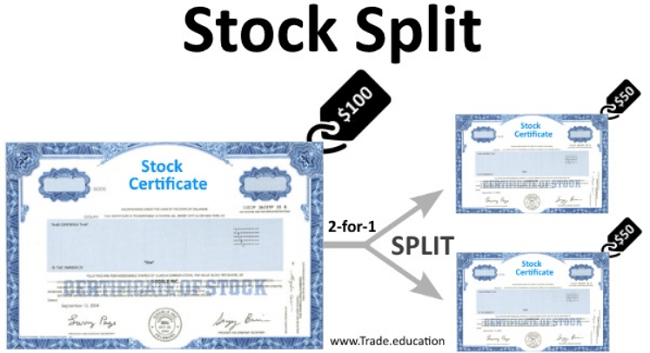 If you’re beginning to invest in stocks, you will one day run into something known as a stock split. If you’re new and inexperienced, you may inherently believe that a stock split is a good thing and can make you wealthier.
If you’re beginning to invest in stocks, you will one day run into something known as a stock split. If you’re new and inexperienced, you may inherently believe that a stock split is a good thing and can make you wealthier.
However it simply isn’t true. A stock split is nothing more than an accounting transaction designed to make the nominal quoted market value of shares more affordable.
In the case of something like a 2-for-1 stock split, it’s economically akin to walking into a bank and exchanging a $20 bill for two $10 bills. But what is a Stock Split?
Editor’s Note: Interested in opening a brokerage account to start investing? Check out the best promotions from Chase, Ally Invest, E*Trade, and TD Ameritrade!
| PROMOTIONAL LINK | OFFER | REVIEW |
| J.P. Morgan Self-Directed Investing | Up to $700 Cash | Review |
| TradeStation | $3500 Cash | Review |
| WeBull | 12 Free Stocks & free trades | Review |
| SoFi Invest | $25 Bonus and free trades | Review |
Stock Split
When a corporations common equity is divided into equal pieces, they become known as shares of common stock. Imagine you set up a lemonade stand a receive 100 shares of stock at $1 each. This gives your lemonade stand $100 to spend on capital and labor.
If your lemonade stand does exceptionally well and begins to grow into different lines of juices and expand into different locations, You franchise the concept and are suddenly collecting royalties on hundreds of units throughout the world.
Ten years later, you find your company generating operating income of $100,000 per year.
At a reasonable valuation rate, and with your current growth trajectory, you might be worth $1,200,000 should you decide to sell it.
You’ve never issued more stock so each of those 100 shares, which represent 1/100th ownership of the business, or 1 percent, are really worth $12,000 despite having $100 in original paid-in capital and capital contributed in excess of par behind it.
Now imagine you have 5 children with whom you want to share gifts with, such as your stock. You don’t want to give them a full share worth $12,000 so you decide to call a meeting with the board of directors and decide to split the stock 10-to-1.
Essentially you split the company into more and smaller pieces. Your 100 shares have now become 1,000 shares.
After all is said and done, you’ll still own the same value of stocks. However for every stock you owned, you now own 10 of them.
The business is still worth $1,200,000, it’s just divided out into 1000 shares instead of 100 valuing each share at $120 rather than $1,200.
Publicly traded companies, including multi-billion dollar blue chip stocks, do this all the time. The firms grow in value thanks to acquisitions, new product launches and share repurchases.
At some point, the quoted market value of the stock becomes too expensive for investors to afford, which begins to influence the market liquidity as there are fewer and fewer people capable of buying a share.
A great example of this was Warren Bruffet’s Holding company. When Buffett began buying the stock to take control back in the 1960’s, he paid $8 or less for some of his shares.
He never split the stock. In the past year, those shares have traded between $186,900 and $227,450 each.
Since this was out of reach for most major investors, he created a special Class B Shares an called the originals Class A Shares.
This set up is an example of dual class structure The B shares originally began at 1/30th of the Class A share value.
Eventually, when Berkshire Hathaway acquired one of the largest railroads in the nation, the Burlington Northern Santa Fe, it split the Class B shares 50-for-1 so that each Class B share now represents 1/1,500th of the Class A shares.
The Class A shares have voting rights, the Class B shares have none.
Companies who decided to split their stock can do it in almost any mathematical ratio. The most common are 2-for-1, although 3-for-1, 2-for-3, and 10-for-1 stock splits are common as well.

What Reasons are There for Stock Splits?
Aside from the per-share nominal affordability we’ve discussed, there are a handful of other benefits of stock splits, including the aforementioned liquidity increase.
The important thing to remember is that stock splits make no one richer. Not you, other traders/investors, or the owner. Everything is of the exact same value.
Many inexperienced investors have believed that they were richer in the case of a stock split, but as mentioned before, a stock split is like exchanging a 20 for two 10’s. You have more, but it’s the exact same value.
Reverse Splits
Although these are uncommon, it is possible for a corporation to reverse a stock split. These always occurred due to a disaster or struggle with the business to avoid being delisted from a major stock exchange, a reverse stock split is the opposite of an ordinary stock split. The purpose is to raise the nominal price of each share.
Bottom Line
Despite the initial thought that you’re wealthier due to more shares being in your account, it doesn’t mean you are. Stock splits are relatively common and can happen anytime anywhere.
You may have twice the number of stocks you’ve had before, but the value of them is the exact same as before.
If you enjoy finding and reading informative posts like these, but sure to check our more posts we have on HMB! Be sure to also check out our posts on Best Brokerage Bonuses and the Best Bank Bonuses!




Leave a Reply